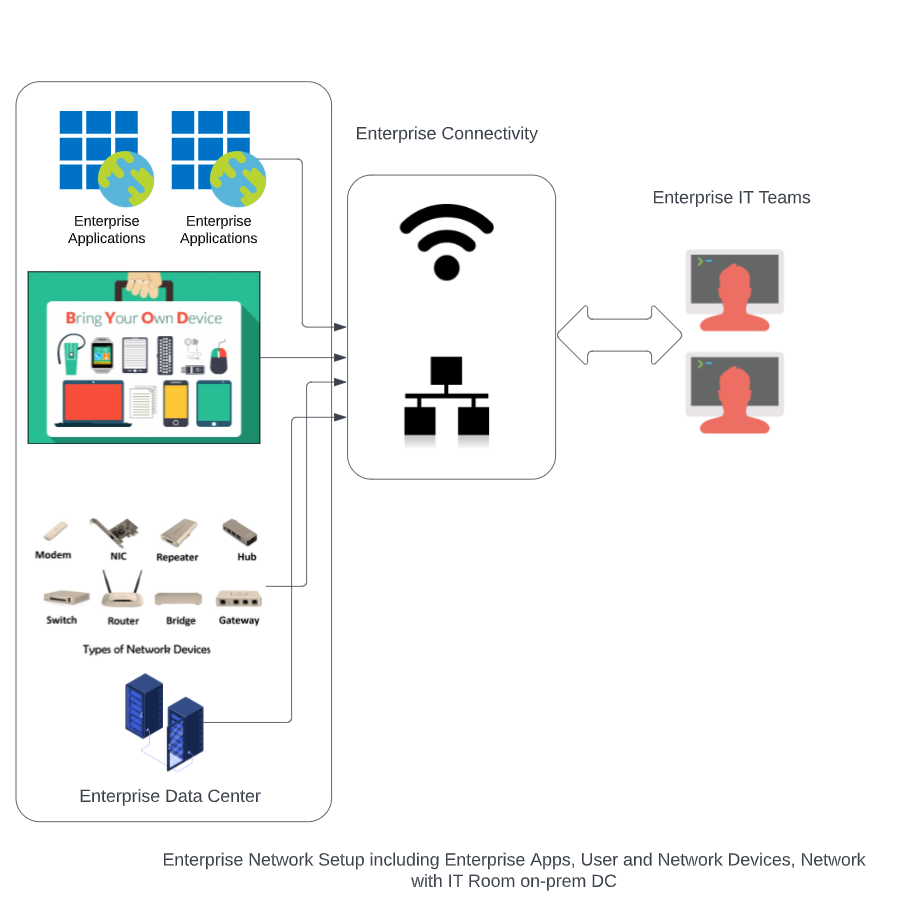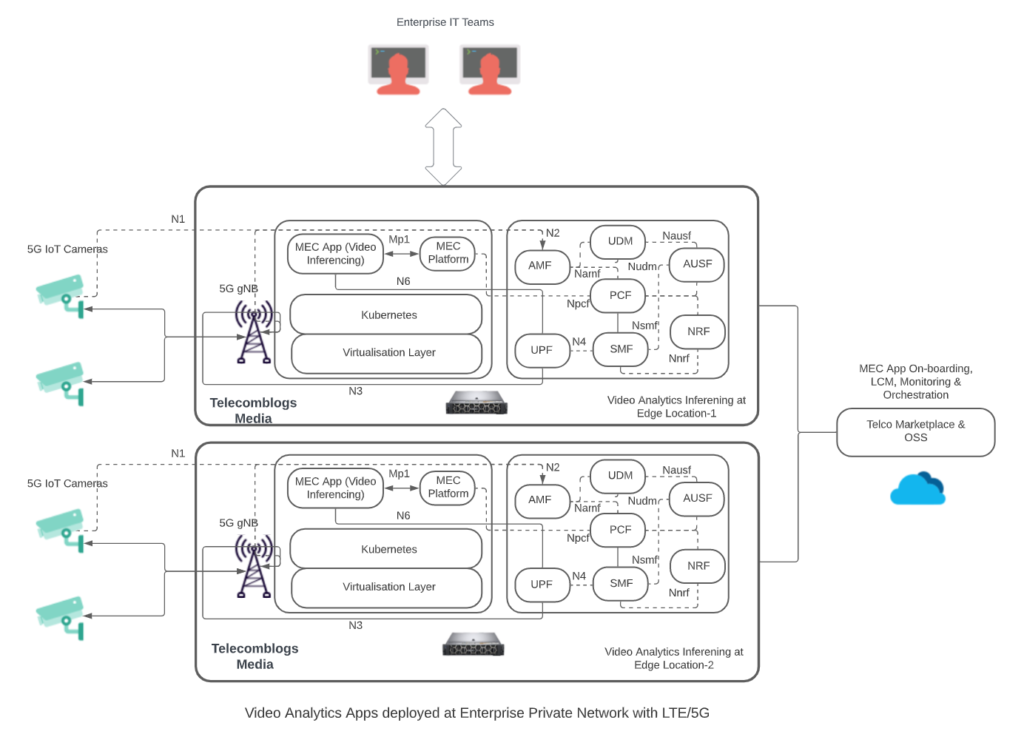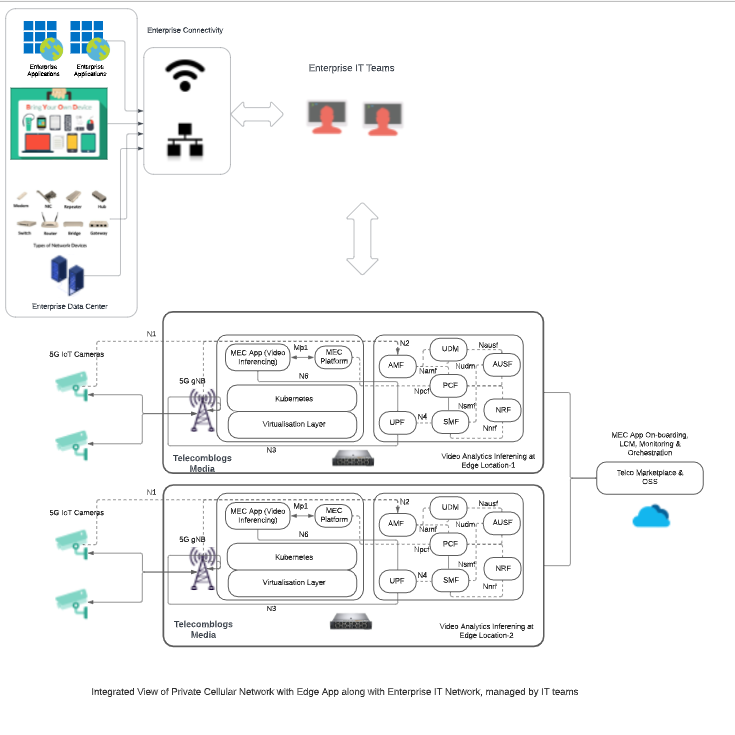Enterprise Networks or IT Networks are the backbone of any enterprise setup. Comprising of diverse set of enterprise apps, servers, storage, network, and user devices. Typically, they are managed by local IT teams round the clock. Traditionally Wi-Fi and/or LAN/Ethernet has been the preferred mode of connecting apps and devices across local areas. Functionally this setup itself is quite diverse, and complex comprising of multiple VLANs, IT Data Centers, Power Systems managed by enterprise IT policies and rule engines. You need to be a ‘Pro’ to design, build and manage these networks.

Enterprise Networks were always privately protected and managed behind IT firewalls and switches. Only a certain portion of the network made public supporting diverse set of use cases. Now a days, many enterprises adopted hybrid cloud approach to build and manage IT workloads, networks are evolving to the next level.
With the arrival of Cellular connectivity on campus, be it LTE or 5G, the scenario is going to change completely. Depending on the deployment options chosen, stand-alone and public integrated stand-alone, the complexity of managing these networks is going to be enormously complicated.
Now let’s take an example of it to understand it better. Let’s say an enterprise, a medium size, already with setup of devices, app and connectivity in place decides to evaluate P5G/PLTE network and already zeroed down to partners, has spectrum and use case is identified, which justifies the investment RoI. These steps themselves are a long-haul process and making choices is not going to be easy, without active participation of multiple industry stakeholders in the process. For sake of simplicity, let’s assume somehow the enterprise has navigated these steps (with so much of struggle), and ready to deploy a video analytics ‘Face Detection’ application on campus.
We are assuming that they have approached a Telco at this stage to help them out in building this on-campus network and here’s what the setup would look like on campus on a prominent level.

If you look at the above architecture, on prominent level, enterprise is deploying 5G/IoT enabled CCTV Cameras, 5G Radio Site (gNB), 5GC components (this could be optional), MEC Application stack (Video Analytics Face Detection App), all on campus. The architecture is more for representation purposes, and some modules components could be deployed with Telco/Public MEC locations depending on Use case requirements and depends on enterprise choice on setting up entire infra on campus. Eventually, the network will be monitored and operationalized by Telco OSS/NOC centers, and Enterprise IT teams will also be managing them as well.
The question comes, what will be the role of Enterprise IT teams in managing these Cellular Private Networks?
It could vary, depending on network deployment model, but in the end, if IT teams aren’t going to manage these Edge apps and networks, enterprises could face dilemma of operating these complex networks. Moreover, if they choose to be on their own (NPN), without Telcos, enterprise’s P5G partners need to help in managing and operating these networks end to end, including app life cycle management, without creating much fragmentation in existing setup.
How will Enterprises solve these challenges?
They could have multiple options though. First, they can outsource entire private network on BOOT(Build-Own-Operate-Transfer) model to partners (including Telco). Second, they could do it mix of responsibilities, partially owning design or operation aspects. Third, they could do it entirely on their own, with the ownership of Enterprise IT teams.
In our design case, the enterprise has chosen to partner with Telco to build this on-prem network, which simplifies certain aspects. Assuming Telco has application ecosystem (app marketplace), end to end app orchestration layer (network slice) built (with Cloud providers), and with integration with OSS/BSS and 5G/4G Core, deployment will happen on Edge platforms, managed by Telco NOC teams. From application perspective (Face Detection), enterprise IT teams may monitor dashboards created specific to Use Case (alerts/events) and may not have full control of app life cycle itself, despite the app being hosted on-campus. This could be a challenge for enterprises initially, but eventually, they will have to gear up to not only manage one application, but an entire suite of Edge applications deployed on-campus with Cellular connectivity.

Enterprise IT team will have multi-fold challenges to tackle here. If you remember our initial setup, without Cellular Networks, it’s quite straightforward for IT teams to manage them, partially because, enterprise app/devices are fully integrated as part of
With Edge/MEC apps, such as Face Detection, although deployed on-campus, is more of carrier grade app, orchestrated, managed, and tightly coupled with cellular ecosystem components. Moreover, the IoT devices, such as CCTVs, will discover these apps directly (DNS resolution), and need to be managed separately as well, bypassing enterprise auth mechanisms (SIM Authentication). Even these CCTVs will get IP addresses from packet core elements, making it difficult for IT teams to control all aspects of private network and MEC App deployments.
Enterprises, in the end, will have to figure out, how their existing investments in IT teams, should support managing, operating both regular Enterprise networks/devices as well P5G networks and Edge Apps together in long run. Moreover, over time, enterprises would want to scale, deploy many such Edge Apps, solving multiple use cases with 5G Networks, which make proposition quite challenging to comprehend. I can imagine, in future, an average enterprise deploying at least 5-10 different edge apps, solving different business problems with help of AI/ML, 5G and Cloud Native technologies.
This brings to an interesting question, on the future of enterprise networks altogether.
In future, we could clearly see enterprises managing not only typical enterprise grade apps (e.g., CRM, HR, Finance, Inventory etc.) but will have many more apps (Edge Apps), solving different business problems with AI/ML including Smart Surveillance, Worker Safety, Parking Management, Smart Buildings etc. Moreover, the enterprise network architecture will have to adapt to integrate with cellular private networks, including Radio, MEC, Core, and others. Depending on deployment models, there could be a larger role of Public MEC, OSS, BSS, and other cellular modules as well in enterprise networks. In addition, as enterprises have already adopted cloud to deploy some or all their workloads, it’s going to add complexity to existing mix of apps, platforms, and solutions. The future is a mix of hybrid workloads, deployed across multi-cloud, on-prem, coupled with edge apps, and cellular networks.
Are enterprises geared for the future of enterprise networks?
Maybe not. It’s a long haul but the journey has already begun. At this stage, I could see enterprises skeptical of adding complexity to their already complex setup, but eventually, if P5G ecosystem (including Telcos) manages to solve the challenges, adoption of the private network, and edge apps going to be easier, enabling enterprises to solve complex business problems with new possibilities.
Moreover, the challenge is everyone is thinking siloed here. Cellular operators or private network operators, thinking from Cellular perspective to design these networks, making it harder for Enterprises and IT teams to adopt these networks. Moreover, IT teams, traditionally skilled at managing Wi-Fi/Ethernet connectivity, network devices and apps, are going to find it difficult to manage Cellular on-prem networks, Edge apps and devices. They need to gear for the next wave right away. Enterprises who are adopting P5G/PLTE networks need to think holistically and create a sustainable handshake to make integration a success.
In many instances, private networks are an integration challenge altogether. How well it gels with existing enterprise ecosystem, and economics of partnerships, selection of use cases will decide of future of enterprise network. The role of enterprise IT teams is more critical than ever, helping enterprises navigate complex path forward.
(All views are personal and don’t represent any org, company, or vendor solutions.)






